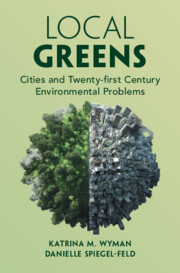Book contents
- Local Greens
- Local Greens
- Copyright page
- Dedication
- Contents
- Figures
- Tables
- Photographs
- Acknowledgments
- Introduction
- 1 A Brief History of Cities in Environmental Policy
- 2 An Analytical Framework
- 3 Local Environmental Protection in NYC
- 4 Decarbonization Efforts in NYC
- 5 Adapting to Climate Change in NYC
- 6 An Urban Climate Change Agenda for the Early Twenty-First Century
- Coda
- Notes
- Index
4 - Decarbonization Efforts in NYC
Published online by Cambridge University Press: 11 October 2025
- Local Greens
- Local Greens
- Copyright page
- Dedication
- Contents
- Figures
- Tables
- Photographs
- Acknowledgments
- Introduction
- 1 A Brief History of Cities in Environmental Policy
- 2 An Analytical Framework
- 3 Local Environmental Protection in NYC
- 4 Decarbonization Efforts in NYC
- 5 Adapting to Climate Change in NYC
- 6 An Urban Climate Change Agenda for the Early Twenty-First Century
- Coda
- Notes
- Index
Summary
In the early twenty-first century, New York and other cities established targets to reduce their greenhouse gas emissions to help limit global climate change. Limiting these emissions is not an obvious task for local governments: no city’s efforts will materially affect planetary temperatures, and curtailing these emissions imposes costs on local actors mainly for the benefit of the world as a whole. Between 2007, when the city set its first GHG reduction target, and 2019, the city’s emission reduction efforts were consistent with the preoccupation of local elites with economic growth. The city did not impose costly requirements on local actors to reduce their emissions, and the city did not achieve significant emission reductions. However, in 2019, the city government passed a local law that establishes declining caps on greenhouse gas emissions from buildings, and portends real costs on private actors – including the owners of residential real estate – if the city enforces the law. This 2019 law emerged from the efforts of city insiders, and local progressive interest groups motivated by environmental, social justice and labor concerns in the first Trump presidency. The history of the city’s efforts to reduce greenhouse gas emissions illustrates the precarious politics of local decarbonization efforts.
Information
- Type
- Chapter
- Information
- Local GreensCities and Twenty-first Century Environmental Problems, pp. 55 - 71Publisher: Cambridge University PressPrint publication year: 2025
Accessibility standard: WCAG 2.0 A
Why this information is here
This section outlines the accessibility features of this content - including support for screen readers, full keyboard navigation and high-contrast display options. This may not be relevant for you.Accessibility Information
Content Navigation
Allows you to navigate directly to chapters, sections, or non‐text items through a linked table of contents, reducing the need for extensive scrolling.
Provides an interactive index, letting you go straight to where a term or subject appears in the text without manual searching.
Reading Order & Textual Equivalents
You will encounter all content (including footnotes, captions, etc.) in a clear, sequential flow, making it easier to follow with assistive tools like screen readers.
You get concise descriptions (for images, charts, or media clips), ensuring you do not miss crucial information when visual or audio elements are not accessible.
You get more than just short alt text: you have comprehensive text equivalents, transcripts, captions, or audio descriptions for substantial non‐text content, which is especially helpful for complex visuals or multimedia.
Structural and Technical Features
You gain clarity from ARIA (Accessible Rich Internet Applications) roles and attributes, as they help assistive technologies interpret how each part of the content functions.
